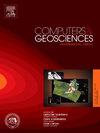一种在球坐标系下实现全球重力正演模拟的新算法和软件
IF 4.4
2区 地球科学
Q1 COMPUTER SCIENCE, INTERDISCIPLINARY APPLICATIONS
引用次数: 0
摘要
我们提出了一种新的全球重力正演建模算法和补充软件,该算法和软件可以适应在球坐标框架中定义的具有复杂形状和密度分布的质量。传统的重力正演建模技术在处理不规则形体和复杂密度变化时往往面临重大挑战,导致计算成本高,处理时间长。为了解决这些实际限制,我们引入了一种创新的算法,该算法将三维质量密度体在径向上划分为等间隔的球形同心圆,同时将纬度和纵向离散为等间隔的网格。离散化后,我们假设每个球形体积质量环具有横向变化的密度和恒定的上下边界。基于这种方法,地球外任何一点的引力场被评估为每个同心圆产生的引力贡献的总和。这种离散化允许应用快速傅里叶变换(FFT)技术大大提高球谐分析和合成的计算效率。数值结果与曲面法在空间域中得到的相应解进行了验证。结果对比表明,该方法具有较高的精度,两种方法的引力和梯度计算结果的相对差异分别小于1%和4%,同时显著提高了计算效率。在对非常复杂的结构,如地球的地壳密度结构,利用其几何和密度分布来模拟引力场量时,数值效率提高了几个数量级。本文章由计算机程序翻译,如有差异,请以英文原文为准。
A novel algorithm and software for efficient global gravimetric forward modeling in the spherical coordinate system
We present a novel algorithm and complementary software for the global gravimetric forward modeling that accommodates masses with complex shapes and density distributions defined in the frame of spherical coordinates. Traditional gravimetric forward modeling techniques often face significant challenges when dealing with irregularly shaped bodies and complex density variations, leading to high computational costs and long processing times. To address these practical limitations, we introduce an innovative algorithm that divides the 3-D mass-density body into spherical concentric rings with equal intervals in the radial direction, while discretizing the latitudinal and longitudinal directions into a grid with equal intervals. After discretization, we assume that each spherical volumetric mass ring has a laterally varying density and constant upper and lower bounds. Based on this approach, the gravitational field at any point outside the Earth is evaluated as the sum of the gravitational contributions generated by each concentric ring. This discretization allows applying the Fast Fourier Transform (FFT) technique to drastically improve computational efficiency of the spherical harmonic analysis and synthesis. Numerical results are validated against corresponding solutions obtained using the tesseroid method in the spatial domain. The comparison of results reassures a high accuracy of proposed method, with relative differences between results obtained from both methods less than 1 % and 4 % for the gravitational attraction and gradient respectively, while significantly improving the numerical efficiency. When modelling the gravitational field quantities of very complex structures by means of their geometry and density distribution, such as the Earth's crustal density structure, the numerical efficiency improved several orders of magnitude.
求助全文
通过发布文献求助,成功后即可免费获取论文全文。
去求助
来源期刊

Computers & Geosciences
地学-地球科学综合
CiteScore
9.30
自引率
6.80%
发文量
164
审稿时长
3.4 months
期刊介绍:
Computers & Geosciences publishes high impact, original research at the interface between Computer Sciences and Geosciences. Publications should apply modern computer science paradigms, whether computational or informatics-based, to address problems in the geosciences.
 求助内容:
求助内容: 应助结果提醒方式:
应助结果提醒方式:


